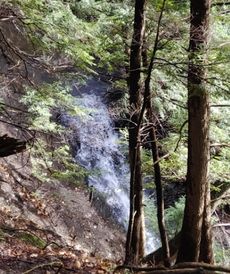
The Native Americans are credited with lighting the flame in one of the grottos of the 35-foot-tall waterfall known as Eternal Flame Falls thousands of years ago. Scientists have long theorized that gas pockets in the old, highly hot shale bedrock fuel the fire. Shale’s carbon molecules are decomposed by the rock’s high temperatures, releasing natural gas.
The shale beneath the waterfall is not old nor hot enough to be responsible for the production of gas pockets. It shouldn’t be able to produce any gas, but it keeps doing so. Many believe another process, different from the one responsible for surface gas production, must be at work to keep gas production underground. That is to say; scientists have yet to determine what, if anything, is responsible for maintaining the eternal flame.
History
An eternal flame is a traditional symbol of hope, remembrance, and appreciation. Near the Tomb of the Unknown Soldier, a propane-powered device stands as a memorial to the war dead of every nation.
According to folklore, the first fire was started many years ago by a Native American. Many people believe that elves make their home in the forest.
The Eternal Flame Falls is the most well-known of the world’s nine naturally occurring eternal flames. Behind a nine-meter waterfall whose flow varies with the rains, a flame 75 centimeters tall flickers in a little shale grotto.
It began to take shape more than 350 million years ago in the Devonian Era. While its flame has a mystical quality, it isn’t always reliable. If it goes out due to high winds or rain, the villagers and tourists relight it using matches.
Geology
The phenomenon occurs because of a mega seep, a location where pressurized natural gas, including ethane, methane, and propane, leaks out of the earth through fissures in the surrounding rock.
Methane is released daily from the seep. In most leaks, methane is digested by soil microbes and converted to carbon dioxide.
You can smell rotten eggs as you get closer to the falls, like natural gas seeping through cracks in the shale layers. The pressure of the gas created by the decay of organic matter forces it to escape through fissures and other openings. In a small cave, you can find one particularly huge crack within Eternal Flame Falls that shields the gas seepage from the crashing water and any breeze.
Two more seeps can be lighted within the grotto; however, neither can support a flame of comparable size. You can find other gas seepages or springs in the area of the falls, but it is impossible to ignite them. Some can be seen rising from the bedrock beneath the pool at the base of the falls.
The flow of water at Eternal Flame Falls depends heavily on precipitation and snowmelt. It doesn’t start to flow until early spring or after prolonged periods of heavy rain. It drops two stages from a shale cliff at 30 feet in height.
The natural gas spring that produces a flame is located in a small grotto, 5 feet up from the creek bed on the right. The water falls over the grotto when the flow is strong, obscuring the flame and spreading the light more evenly. There aren’t many other waterfalls like Eternal Flame Falls in the United States. It’s also one of the few untouched ecosystems left on Earth.
How Do You Visit Eternal Flame Falls?

There are two ways to get there:
Proceed to the A-Intersection from the beginning of the trailhead. This trailhead has better parking and more clearly marked directions to the Flame than the other. The current parking lot was once used as a horse corral. Leave the car and follow the path into the woods from the parking lot. Look for the small flame trail markers painted on the trees; these will lead you to the bottom of the ravine. Make your way through a forest of hemlocks.
Another way to reach there is through the trailhead on Seufert Road. It once served as the primary entrance to the Shale Creek Preserve. You can find some beautiful spots along the roadside. Stay on the trail by following the blue block trail markings until you reach Intersection A. Follow the blue bricks past the fence, and you’ll find yourself on a jeep trail.
Crossroads C is an unmarked trail junction. If you follow this unmarked path, you’ll get a good look at the waterfall from above, but you won’t be able to get down into the canyon below.
You’ll need to hop across a little creek using the rocks. Your springtime footwear can become wet if you try to cross this stream without a bridge. You’ll have to trudge up a short hill. The path to the Eternal Flame is off to the left.
Another way to reach there is through Waterfalls Trailhead A.
You can reach Intersection A on foot either from Chestnut Ridge Road or Seufert Road. Follow the path into the ravine, and you’ll reach the Eternal Flame Falls. The track is delineated by blue blocks and metal flame signs.
Take the trail on the ridge above the creek and go north from the intersection. You’ll be able to make out the rushing river below and catch views of the ravine off to your left. Start your descent into the gorge at.34 miles from the Corral TH. Follow the stream bed up Shale Creek Gorge after bearing left on the route. Choose your route carefully, as the rocks might be slick.
Final Words
Despite being one of the most distinctive waterfalls in the state, if not the country, a visit to Eternal Flame Falls is marred by its muddy surroundings, erratic water flow, and a large amount of trash littering the valley. You should definitely visit this place if you find yourself in wet-season western New York with an hour to kill.
